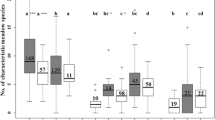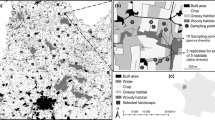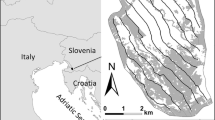Abstract
We explored patterns of plant species richness at different spatialscales in 14 habitats in a Swedish rural landscape. Effects of physicalconditions, and relationships between species richness and management historyreaching back to the 17th century were examined, using old cadastralmaps andaerial photographs. The most species-rich habitats were dry open semi-naturalgrasslands, midfield islets and road verges. Alpha diversity (species richnesswithin sites) was highest in habitats on dry substrates (excluding bedrock withsparse pines) and beta diversity (species richness among sites) was highest inmoist to wet habitats. Alpha and beta components of species richness tended tobe inversely related among habitats with similar species richness. Managementhistory influenced diversity patterns. Areas managed as grasslands in the17th and 18th century harboured more species than areasoutside the villages. We also found significant relationships between speciesrichness and soil type. Silt proved to be the most species-rich topsoil(10–20 cm) in addition to thin soils top of on green- orlimestone bedrock. The variation in species richness due to local relief orform of thesite also showed significant relationships, where flat surfaces had the highestnumber of species. In contrast, no significant relationship was found betweenspecies richness and aspect. Our study suggests that present-day diversitypatterns are much influenced by management history, and that small habitat,e.g., road verges and midfield islets, are important for maintaining speciesrichness.
Similar content being viewed by others
References
Åkerlund A. 1996. Human Responses to Shore Displacement. Living by the Sea in Eastern Middle Sweden during the Stone Age. PhD Dissertation, Stockholm university, Stockholm, Sweden.
Anonymous 1992. Ängs-och hagmarker i Södermanlands län. Länstyrelsens landsbygdsenhet, Södermanlands län, Nyköping, Sweden, (In Swedish).
Aronsson M., Hallingbäck T. and Mattsson J.-E. (eds) 1995. Swedish Red Data Book of Plants 1995 Artdatabanken., Uppsala, Sweden, (In Swedish: Rödlistade arter i Sverige 1995).
Austrheim G., Olsson E.G.A. and Grøntvedt E. 1999. Land-use impact on plant communities in semi-natural grasslands of Budalen, central Norway. Biological Conservation 87: 369-379.
Bakker J.P. 1989. Nature Management by Grazing and Cutting. Kluwer Academic Publishers, Dordrecht, The Netherlands.
Berglund B.E. 1991. The Late Bronze Age landscape; Landscape, land use and vegetation. Ecological Bulletins 41: 73-77.
Berglund B.E., Digerfelt G., Engelmark R., Gaillard M.-J., Karlsson S., Miller U. et al. 1996. Sweden. In: Berglund B.E., Birks H.J.B., Ralska-Jasiewczowa M. and Wright H.E. (eds), Palaeoecological Events During the Last 15 000 Years: Regional Synthesis of Palaeoecological Studies of Lakes and Mires in Europe. John Wiley and Sons Ltd, Sweden.
Birkeland P.W. 1999. Soils and Geomorphology. Oxford University Press, Oxford, UK.
Brunnberg L. 1995. Clay-varve chronology and deglaciation during the Younger Dryas and preboreal in the easternmost part of the Middle Swedish Ice Marginal Zone. Quaternaria. Serie A No 2. PhD Dissertation, Stockholm university, Stockholm, Sweden.
Collins S.L. and Glenn S.M. 1990. A hierarchical analysis of species abundance patterns in grassland vegetation. American Naturalist. 135: 633-648.
Cousins S.A.O. 2001. Analysis of land-cover transitions based on 17th and 18th century cadastral maps and aerial photographs. Landscape Ecology 16: 41-54.
Cousins S.A.O. and Ihse M. 1998. A methodological study for biotope and landscape mapping based on CIR aerial photographs. Landscape and Urban Planning 41: 183-192.
Cousins S.A.O. and Eriksson O. 2001. Plant species occurrence in a rural hemiboreal landscape: effects of remnant habitats, site history, topography and soil. Ecography 24: 461-469.
Cousins S.A.O., Eriksson Å. and Franzén D. Reconstructing past land use and vegetation patterns using palaeogeographical and archaeological data. A focus on grasslands in Nynäs by the Baltic Sea in south-eastern Sweden. Landscape and Urban Planning (in press).
Duchaufour P. 1982. Pedology. George Allen & Unwin, London, UK, (English edition).
Eriksson Å. 1998. Regional distribution of Thymus serpyllum: management history and dispersal limitation. Ecography 21: 35-43.
Eriksson Å. and Eriksson O. 1997. Seedling recruitment in seminatural pastures: the effects of disturbance, seed size, phenology and seed bank. Nordic Journal of Botany 17: 469-482.
Eriksson Å., Eriksson O. and Berglund H. 1995. Species abundance patterns of plants in Swedish semi-natural pastures. Ecography 18: 310-317.
Eriksson O. 1996. Regional dynamics of plants: a review of evidence for remnant, source-sink and meta-populations. Oikos 77: 248-258.
Forman R.T.T. 1995. Land Mosaics-The Ecology of Landscapes and Regions. Cambridge University Press, Cambridge, UK.
Fries M. 1965. Outlines of the Late-Glacial and Postglacial Vegetational and Climatic History of Sweden, Illustrated by Three Generalized Pollen Diagrams. Special paper 84. The Geological Society of America Inc.
Goldberg D.E. and Landa K. 1991. Competitive effect and responsehierarchies and correlated traits in the early stages of competition. Journal of Ecology 79: 1013-1030.
Grace J.B. 1999. The factors controlling species density in herbaceous plant communities: an assessment. Perspectives in Plant Ecology, Evolution and Systematics 2: 1-28.
Huston M.A. 1999. Local processes and regional patterns: appropriate scales for understanding variation in the diversity of plants and animals. Oikos 86: 393-401.
Huston M.A. 1994. Biological Diversity. The Coexistence of Species on Changing Landscapes. Cambridge University press, Cambridge, UK.
Ihse M. 1995. Swedish agricultural landscapes: patterns and changes during the last 50 years, studied by aerial photos. Landscape and Urban Planning 31: 21-37.
Kain R.J.P. and Baigent E. 1992. The Cadastral Map in the Service of the State: A History of Property Mapping. The University of Chicago Press, London, UK, 423 pp.
Kienast F. 1993. Analysis of historic landscape patterns with Geographical Information System-a methodological outline. Landscape ecology 8: 103-118.
Kohn D.D. and Walsh D.M. 1994. Plant species richness-the effect of island size and habitat diversity. Journal of Ecology 82: 367-377.
Kull K. and Zobel M. 1991. High species richness in an Estonian wooded meadow. Journal of Vegetation Science 2: 711-714.
Lennartsson T. and Svensson R. 1996. Patterns in the decline of three species of Gentianella (Gentianaceae) in Sweden, illustrating the deterioration of semi-natural grasslands. Symb. Bot. Ups. 31: 169-184.
Lidmar-Bergström K. 1995. Relief and saprolites thorough time on the Baltic Shield. Geomorphology 12: 45-61.
Lincoln R., Boxshall G. and Clark P. 1998. A Dictionary of Ecology, Evolution and Systematics. Cambridge University press, Cambridge, UK.
McLean E.O. 1982. Soil pH and Lime Requirement. In: Page A.L. (ed.), Methods of Soil Analysis. Chemical and Microbiological Properties. Agronomy 9, Madison., Wisconsin, USA.
Nilsson S.G. and Ericson L. 1992. Conservation of plant and animal populations in theory and practice. In: Hansson L. (ed.), Ecological Principles of Nature Conservation. Elsevier, London, UK.
Norderhaug A., Ihse M. and Pedersen O. 2000. Biotope patterns and abundance of meadow plant species in a Norwegian rural landscape. Landscape ecology 15: 201-218.
Olsson M. 1999. Soil survey in Sweden. In: Bullock P., Jones R.J.A. and Montanarella L. (eds), EUR18991-Soil Resources of Europe. Rep. no. 6. Office for Official Publications of the European Communities, Luxembourg.
Olsson G. and Risberg J. 1995. Archaeological data and models of sea-level changes c. 6000-3500 BP south of Stockholm, eastern Sweden. In: Robertsson A.-M., Hackens T., Hicks S., Risberg J. and Åkerlund A. (eds), Landscapes and Life. Studies in Honour of Urve Miller. PACT, pp. 219-230.
Poschlod P. and Bonn S. 1998. Changing dispersal processes in the central European landscape since the last ice age: an explanation for the actual decrease of plant species richness in different habitats? Acta Bot. Neerl. 47: 27-44.
Pärtel M., Mändla R. and Zobel M. 1999. Landscape history of a calcareous (alvar) grassland in Hanila, western Estonia during the last three hundred years. Landscape Ecology 14: 187-196.
Pärtel M. and Zobel M. 1999. Small-scale plant species richness in calcareous grassland determined by the species pool, community age and shoot density. Ecography 22: 153-159.
Rudberg S. 1961. Geology morphology. In: Sømme A. (ed.), A Geography of Norden. and Colour Map 4. Cappelen, Oslo, Norway, pp. 27-40.
Schluter D. and Ricklefs R.E. 1993. Species diversity: an introduction to the problem. In: Ricklefs R.E. and Schluter D. (eds), Species Diversity in Ecological Communities. Univ. of Chicago Press, Chicago, Illinois, USA.
Survey Division Staff Soil 1993. Soil Survey Manual. US Dept. of Agriculture Handbook 18, Washington, D.C., USA, 437 pp.
Tyler G. 1996. Cover distributions of vascular plants in relation to soil chemistry and soil depth in a granite rock ecosystem. Vegetatio 127: 215-223.
Welinder S., Pedersen E.A. and Widgren M. 1998. Det svenska jordbrukets historia: Jordbrukets första femtusen år. Natur och Kultur/LTs förlag, Borås, 504 pp. (In Swedish).
Whittaker R.H. 1975. Communities and Ecosystems. 2nd edn. MacMillan, New York, New York, USA.
Wiklander L. 1976. Marklära., Uppsala, (In Swedish).
Wilson E.O. 1994. Naturalist. Island press, Washington, D.C., USA, 390 pp.
Zobel M. 1992. Plant species coexistence-the role of historical and evolutionary and ecological factors. Oikos 65: 314-320.
Author information
Authors and Affiliations
Rights and permissions
About this article
Cite this article
Cousins, S.A., Eriksson, O. The influence of management history and habitat on plant species richness in a rural hemiboreal landscape, Sweden. Landscape Ecol 17, 517–529 (2002). https://doi.org/10.1023/A:1021400513256
Issue Date:
DOI: https://doi.org/10.1023/A:1021400513256




